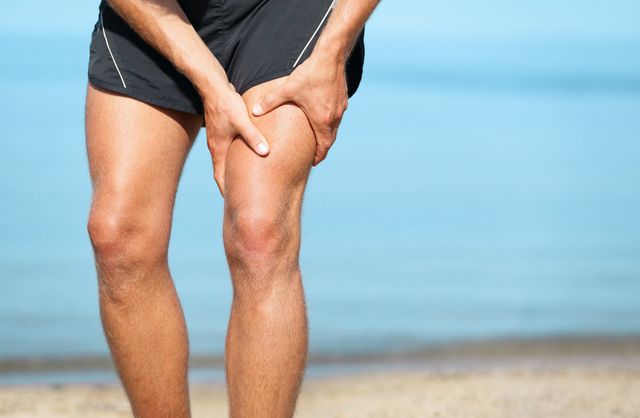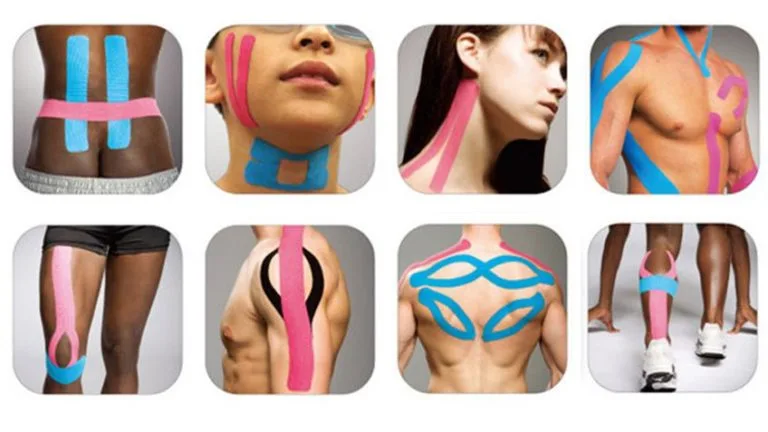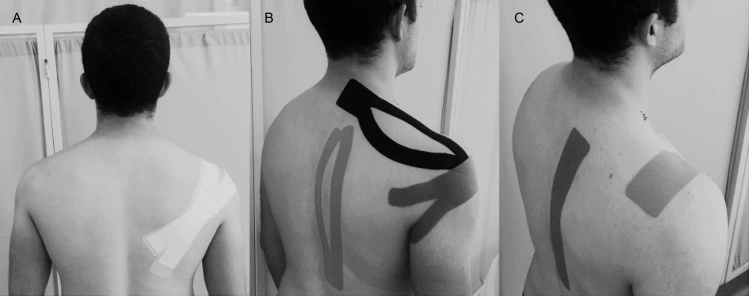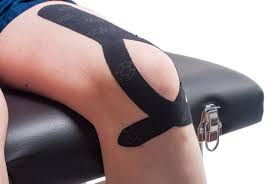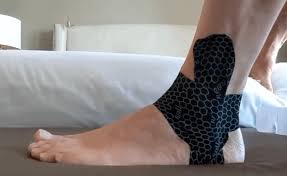Kinesio taping for IT band syndrome
Table of Contents
introduction :
Kinesio taping for IT band syndrome is a most used technique to relieve pain and further support to involve the area and also prevent further injury. This is the most effective and supportive treatment.
It gives static as well as dynamic support to the affected area. kinesio taping gives dynamic stability to the joint while typical taping gives static stability to the affected area.
it’s also called kinesiology tape recording or kinesiology therapeutic tape recording. It is an elastic cotton strip with an acrylic adhesive purported to ease pain and disability from athletic injuries and various other physical diseases.
Taping help stabilizes it when you’re active and can give relief from pain. substantially used in sports injuries because ankle joints are more pron during sports.
Kinesiology taping is an excellent way to capitalize on your hands-on efforts when working to reduce tone in muscular tissues.
Kinesiological tapping could be a rehabilitative cum protecting use of elastic kinesiological tapes to supply :
- reduction in pain
- enhancing performance
- preventing any injuries
- support to the involved area
- repositioning of structure
- facial and ligamentous correction.
Iliotibial band syndrome( ITBS or IT band syndrome) is an overuse injury of the connective tissues that are located on the
the lateral or outer part of the thigh and knee.
It causes pain and tenderness in those areas, just above the knee joint. It’s frequently associated with running, cycling, hiking and weight-lifting.
It’s considered an anon-traumatic overuse injury, frequently seen in runners, and is frequently concomitant with underlying weakness of hip abductor muscles.
The current theory is that this condition is likely caused by compression of the innervated local adipose tissue.
Relevant anatomy :
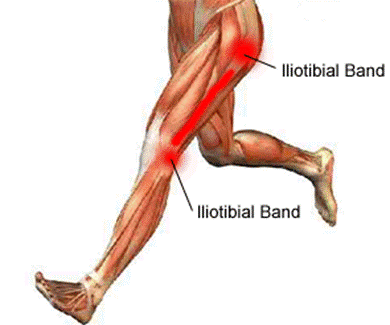
- The iliotibial tract is a thick band of fascia that runs on the lateral side of the thigh from the iliac crest and inserts at the knee. It’s composed of thick fibrous connective tissue that appears from them. tensor fasciae latae.
- gluteus maximus.It descends along the lateral aspect of the thigh, between the layers of the superficial fascia, and inserts onto the lateral tibial plateau at a protuberance known as Gerdy’s tubercle. In its distal portion, the iliotibial tract covers the lateral femoral epicondyle and gives an expansion to the lateral border of the patella.
- While the iliotibial band doesn’t have any boney attachments as it courses between the Gerdy tubercle and the lateral femoral epicondyle, this absence of attachment allows it to move anteriorly and posteriorly with the knee flexion and extension.
Symptoms of IT band syndrome :
- iliotibial band syndrome symptoms range from a penetrating sensation just above the knee and outside of the knee( lateral side of the knee) joint, to swelling or thickening of the tissue in the area where the band moves over the femur.
- The smarting sensation just above the knee joint is felt on the outside of the knee or along the entire length of the iliotibial band.
- Pain may not occur immediately during activity, but may intensify over time. Pain is most commonly felt when the foot strikes the ground, and pain might persist after activity.
- Pain may also be present above and below the knee, where the ITB attaches to the tibia.
Causes of iliotibial band syndrome :
Iliotibial band syndrome can result from one or further of the following A) training habits, B) anatomical abnormalities, or C) muscular imbalances :
A) Training habits :
Spending long periods of time regularly sitting in lotus posture in yoga. Especially beginners forcing the feet onto the top of the thighs constantly running on a horizontally banked surface( similar to the shoulder of a road or an indoor track) on which the downhill leg is bent slightly inward, causing extreme stretching of the band against the femur.
- Inadequate warm-up or cool-down
- Excessive uphill and down-hill handling
- Positioning the feet” toed-in” to an excessive angle when cycling.
- Running up and down stairs
- Hiking long distances
- Rowing
- Breaststroke
- Treading water
B) Abnormalities in leg/ feet anatomy :
- High or low arches
- Supination of the foot
- inordinate lower-leg rotation due to over-pronation
- Excessive foot-strike force
- Uneven leg lengths
- Bowlegs or tightness about the iliotibial band.
C) Muscle imbalance :
- Weak hip abductor muscles
- Weak/non-firing multifidus muscle
- Uneven left-right stretching of the band, which could be caused by habits similar to sitting cross-legged
Risk factors :
- Lack of strength or flexibility. However, called hip adductors, are weak, If the muscles at the inside of the thigh. Similarly, if other thigh muscles are too tight the iliotibial band may also come tight.
- Skipping warm-up exercises. While it has tempted to jump right into a workout, muscles and soft tissue will benefit from 5 or10 minutes of warm-up exercise before assembling up to the more intense activity.
- Ramping up training too fast. An ambitious training schedule is not always good for joints. To avoid iliotibial band syndrome and other injuries, athletes are advised to slowly add to the length and intensity of their exercises over several weeks or months.
- Wearing indecorous footwear. How the foot lands on the ground can affect not just joints in the foot and ankle, but also the knee, the hip, and the muscles and other soft tissue that support those joints. Proper footwear can improve biomechanics and reduce or prevent iliotibial band pain.
Taping technique :
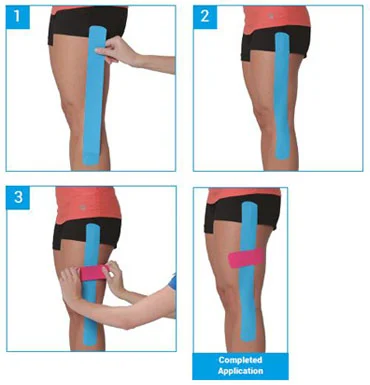
Developed by. Kenzo Kase in 1979. The Kinesio Taping Method is the definitive rehabilitative taping system of knowledge and is designed to facilitate the body’s natural healing process while furnishing support and stability to muscles and joints
without restricting the body’s range of motion, as well as providing extended soft tissue manipulation to prolong the benefits of manual therapy administered within the clinical setting.
Latex-free and wearable for days at a time, Kinesio Tape is safe for populations ranging from pediatric to senior, and successfully treats a variety of orthopedic, neuromuscular, neurological, and other medical conditions.
The Kinesio Taping Method is a therapeutic taping technique not only offers you the support you’re looking for but also assists in the rehabilitation of injury and physiological dysfunction. Then we used two types of taping techniques.
Application of Kinesio taping for IT band syndrome:
- Measure and cut 1 I Strip from just below the knee to the hip bone. Remove a small section of the paper backing from the anchor of the Strip and place the anchor on the outside of the leg, just below the knee with no pressure.
- Without stretching the tape recording, peel down the paper backing and apply the strip over the iliotibial Band,
- ending without pressure at the hip. Rub the tape recording to activate the adhesive.
- Optional Strip
- Measure and cut 1 I Strip. Tear paper backing in the center of the tape recording and apply 10- 15
- pressure, placing directly over the area of pain. Lay down the ends without pressure. Rub the tape recording to activate the glue.
How to remove KT tape?
- When removing the tape, it’s important to ensure you don’t just tear it off as you could damage your skin and cause irritation.
- To begin, ensure you are removing the product in the direction of your hair growth, to lessen any discomfort experienced. Ease it off carefully, folding the edge of the tape back slowly.
- Make sure to check that you’re peeling the removed tape back against the still applied tape at an angle, as opposed to just ripping it off.
- With your other hand, pull your skin taut and tug gently but firmly in the opposite direction of the applied tape, to assist in separating skin and tape and to ensure minimal discomfort.
- If you have not shaved before applying the tape and the area of the body you have treated has a lot of hair growth, it’s a good idea to press down firmly on the tape as you are peeling it back, in order to reduce pain.
- Alternatively, you can apply an adhesive dissolving agent like baby oil, rubbing it in and leaving for approximately 5 minutes, before attempting to remove the tape slowly.
- This will lessen the stickiness and ensure a smooth removal, with no pain.
- Always use a product like baby or olive oil to remove Kinesio or rigid tape if you have sensitive skin or are prone to irritation.
- When you need to remove Kinesio or rigid tape, take care to pull it gently and at a slight angle, in the direction of any hair growth, pulling your skin taut with your other hand.
- Doing it this way will minimize any discomfort or pain and will ensure your skin is not listed as the tape is removed. You can encourage easier removal by stretching the skin behind the tape with a fingertip.
- When you need to remove Kinesio or rigid tape, take care to pull it gently and at a slight angle, in the direction of any hair growth, pulling your skin taut with your other hand.
- Doing it this way will minimize any discomfort or pain and will ensure your skin is not listed as the tape is removed.
- You can encourage easier removal by stretching the skin behind the tape with a fingertip. If you have sensitive skin or want an even gentler removal, cover the tape with a dissolving agent like olive oil or baby oil, leave for a few minutes, then ease the product off carefully.

